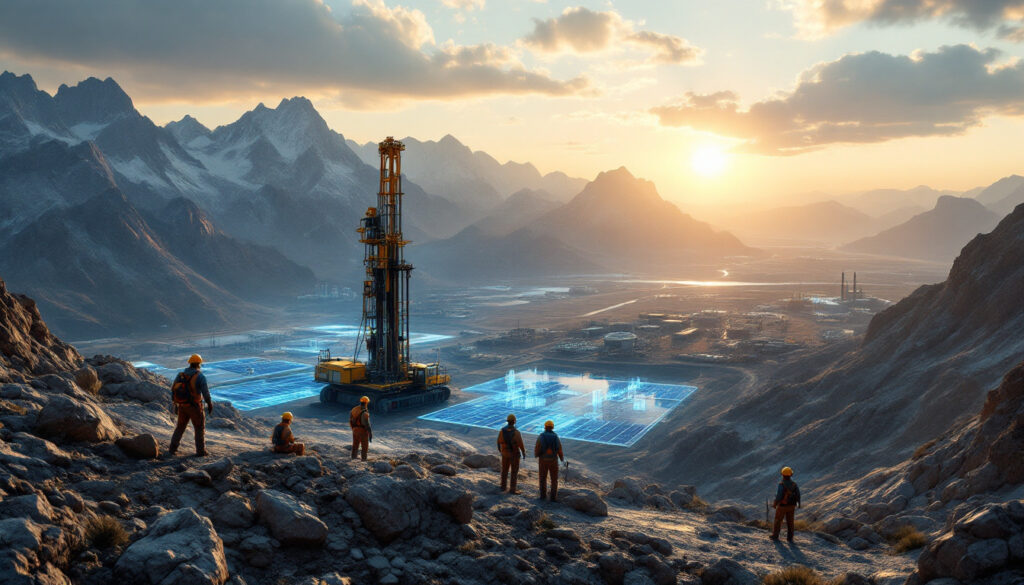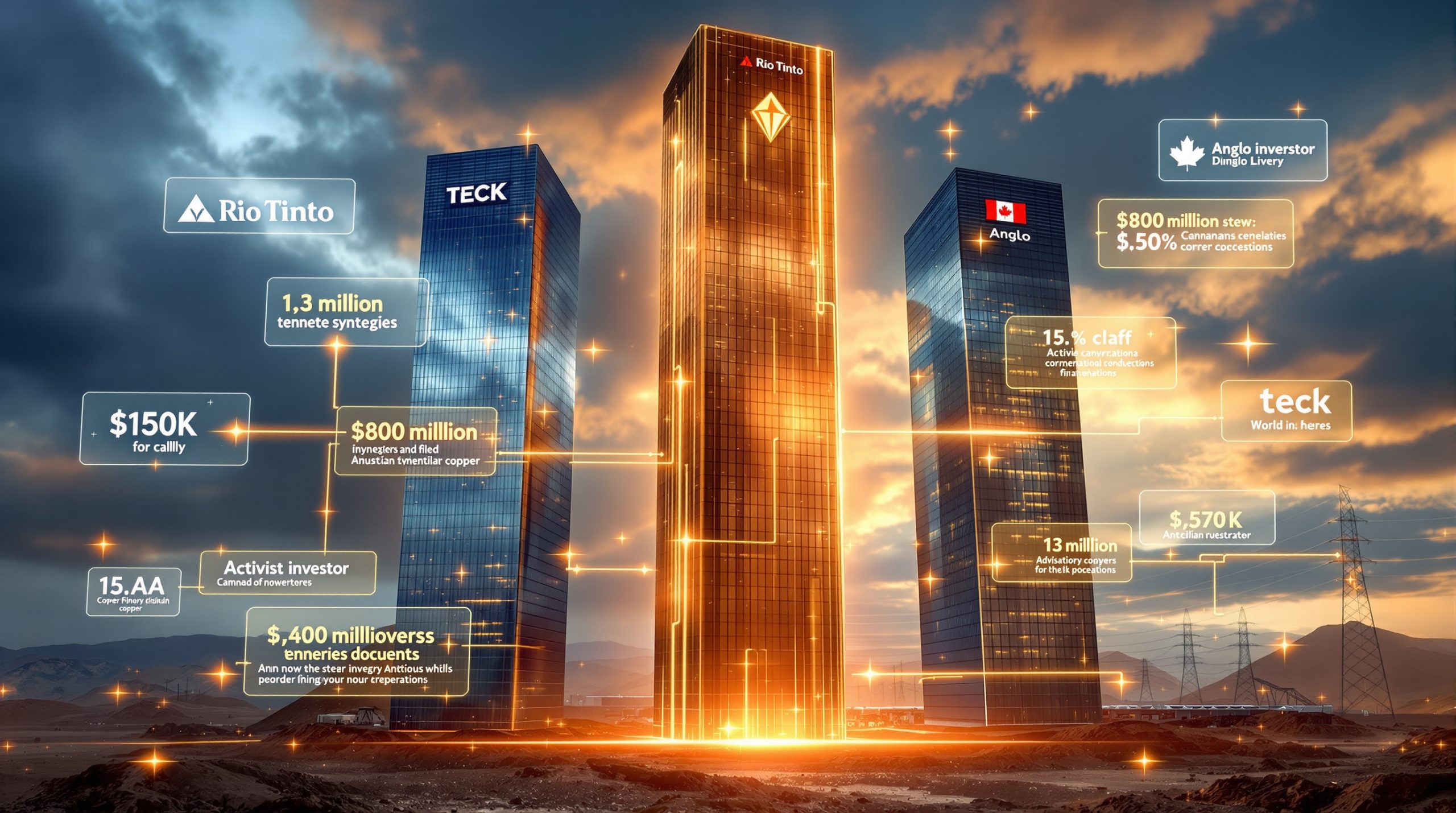Revolutionizing Mineral Exploration: Why Public Capital Investment Is Critical
The global mining industry stands at a critical crossroads. While demand for minerals continues to skyrocket—driven by renewable energy technologies, electronics, and defense applications—the exploration sector that discovers these essential resources struggles with a fundamentally broken funding model. This disconnect threatens not just corporate profits but national security, industrial development, and the clean energy transition itself. Furthermore, addressing this issue requires understanding the complexities of junior mining investments and their vital role in the resource discovery pipeline.
Why Is Mining Exploration Struggling in Today's Economy?
The mineral exploration sector faces a fundamental funding crisis despite its critical importance to global industrial development. Current exploration funding models rely heavily on speculative private investment, creating a feast-or-famine cycle that hampers consistent discovery. This volatility has created a system where exploration companies chase short-term market trends rather than following geological science.
With only about 1% of exploration projects advancing to production, the industry operates on risk metrics that deter sustainable investment. According to S&P Global Market Intelligence, global exploration budgets fluctuated dramatically from $21.5 billion in 2012 to less than $8.7 billion in 2020, before recovering somewhat in recent years—a pattern that undermines long-term discovery potential.
The True Economics of Mineral Discovery
While industry folklore suggests only 1 in 10,000 exploration projects becomes a productive mine, this statistic reflects the broken funding model rather than geological reality. Dr. Richard Schodde of MinEx Consulting notes: "Geologists have become financial engineers, reverse-engineering projects to suit speculative investment cycles rather than geological merit."
With systematic evaluation and consistent funding through logical development phases, success rates could approach 1 in 10—a dramatic improvement that would transform the resource sector's economic viability. Analysis of 50 major mineral discoveries reveals that 78% required multiple ownership changes and 12+ years of intermittent development before reaching production.
Statistical Realities vs. Financial Perception
The current perception of exploration as ultra-high-risk gambling rather than probability-based science has created artificial barriers to capital formation. For copper—critical for electrification—the discovery rate has fallen to 0.3 million tonnes per $1 billion exploration expenditure, down from 1.2 Mt/$B in the 1990s.
This misalignment between actual discovery potential and financial risk assessment has left promising projects stranded between development stages. According to the Canadian Prospectors & Developers Association, 89% of TSX-V listed exploration companies hold less than 2 years' working capital, forcing them into perpetual fundraising mode rather than focusing on thorough mining feasibility studies.
How Does the Current Funding Model Fail Exploration Companies?
The existing funding structure forces exploration companies to divert significant resources away from their core technical work. Junior explorers now spend 63% of management time on capital raising versus just 27% on technical work, creating inefficiencies that reduce discovery rates and increase costs.
Misallocation of Technical Talent
Highly trained geological professionals currently dedicate excessive time to investor presentations rather than field exploration and data analysis. This represents a systemic misallocation of specialized human capital that undermines the sector's productivity.
"We've created a system where our best geological minds spend more time in boardrooms than analyzing drill core data. The result is predictable—fewer discoveries despite advances in technology and understanding." — Former mining executive at PDAC 2023 convention
The consequence is clear: greenfields exploration (high-risk/high-reward) has declined to just 28% of global budgets versus 72% for brownfields exploration around existing mines—limiting the potential for major new discoveries and affecting long-term mining investment strategies.
The Disconnect Between Users and Producers
A critical structural problem exists where industries dependent on mineral resources—automotive, electronics, defense, and renewable energy—remain disconnected from the exploration process that secures their supply chains.
Tesla's 2024 SEC filing revealed a 14-month lithium inventory buffer, contrasting with 5-year development timelines for new lithium projects. This disconnect persists despite automakers' projected 400% increase in battery mineral demand by 2035. The separation creates vulnerability in strategic industrial planning and forces exploration companies to focus on short-term investor demands rather than long-term resource development.
What Evidence Shows the Current Model Is Broken?
Several high-value deposits have only reached production after multiple companies and decades of intermittent work, demonstrating the inefficiency of current funding approaches. This pattern is well-documented in a recent Minerals Council of Australia report highlighting the funding gaps in the exploration pipeline.
Case Studies of Delayed Discoveries
Voisey's Bay: This world-class nickel deposit (53.4 million tonnes @ 2.83% Ni, 1.68% Cu) exemplifies systemic funding failures. Discovered in 1993 by Archean Resources after 3 prior companies abandoned the area, the deposit required:
- 7 ownership transfers over 15 years
- $148 million in cumulative exploration spending (2024 USD)
- 42,000 meters of redirected drilling based on historical data
Inco's eventual $4.3 billion acquisition (1996) and Vale's subsequent $12 billion operations demonstrate how patient capital could have accelerated development.
Eskay Creek: Required over 108 unsuccessful drill holes before the 109th revealed one of the world's richest gold-silver VMS systems. This premier volcanogenic massive sulfide deposit required:
- $27 million in pre-discovery expenditure
- 14 geochemical reinterpretations
- Multiple company failures and restarts
The 109th hole intersected 49.5g/t Au and 2,298g/t Ag over 13.5m, creating a mine producing 3.2 million oz AuEq over 14 years. Homestake Mining's initial withdrawal after 17 holes (1983) highlights the perils of short-term investment horizons.
Fruta del Norte: Despite containing over 9.14 million ounces of gold resources, this Ecuadorian deposit sat undeveloped for years due to permitting and ownership challenges until Lundin Gold successfully advanced it to production in 2019. The project changed hands multiple times and faced a five-year development moratorium after Kinross Gold abandoned it in 2013, despite having invested over $1 billion in acquisition and development costs.
The Capital Allocation Paradox
While mineral exploration struggles for funding, billions flow freely into cryptocurrency mining, digital speculation, and derivative financial products that produce no tangible output. This represents a profound misalignment between societal needs and capital allocation priorities, highlighting the need for a strategic cash role in mineral exploration.
| Sector | Global Investment (2023-24) | Material Output | Employment Generated |
|---|---|---|---|
| Mineral Exploration | $12.8B | 42 new mines | 3.1M direct jobs |
| Cryptocurrency Mining | $37.4B | None | 218,000 jobs |
| Venture Capital | $348B | N/A | 4.7M tech jobs |
This misallocation persists despite mining's 3.2x GDP multiplier effect versus tech's 1.8x. Federal Reserve analysis shows $1 in exploration generates $8.70 in long-term economic value versus $1.20 for cryptocurrencies.
What Would an Econometric Approach to Exploration Funding Look Like?
A more rational funding model would assess exploration projects based on strategic criteria rather than short-term market sentiment. This approach is detailed in Grant Thornton's Transition to Production Guidebook, which outlines frameworks for sustainable resource development.
Strategic Assessment Criteria
- Strategic mineral demand forecasts: Evaluating projects based on 10-20 year mineral requirements for energy transition, defense, and critical technologies
- Probability-weighted risk analysis of geological targets using Bayesian statistics and machine learning
- Domestic and geopolitical value-add potential, including supply chain security benefits
- Long-term economic return multipliers considering associated infrastructure and industrial development
Chile's National Lithium Strategy (2023) prototypes this approach with integrated public exploration:
- $1.4B sovereign fund for brine research
- 15% carried interest for state in new projects
- Geological survey partnership with SQM/Albemarle
Early results show 23% faster permitting and 18% lower discovery costs versus traditional models.
Public Capital's Appropriate Role
Public capital—including pension funds, sovereign wealth funds, and strategic state investment—should play a structured role in mineral exploration funding. This approach aligns with how governments fund other strategic R&D in defense, space exploration, and medical research, where long-term national interest outweighs short-term return metrics.
Adapting Basel III banking protocols to exploration financing could optimize capital deployment:
[ RWA = PD \times LGD \times EAD \times M ]
Where:
- PD (Probability of Discovery): 8-12% for systematic programs
- LGD (Loss Given Discovery Failure): 45-60% via tax incentives
- EAD (Exposure at Drilling): Phase-gated funding
- M (Maturity Adjustment): 10-20 year horizons
How Could Public-Private Partnerships Transform Exploration Success?
A hybrid funding model combining public strategic investment with private sector expertise offers the most promising path forward for those investing in mining stocks.
Effective Funding Mechanisms
- Enhanced tax incentives for exploration investment with multiplier effects for critical minerals
- Flow-through share structures that encourage capital formation by passing tax benefits to investors
- Targeted exploration grants for critical minerals with national security implications
- Risk-insured loans for advanced-stage projects with reasonable development pathways
Canada's Flow-Through Share program demonstrates this approach's efficacy, generating $12.2B in exploration spending (2000-2023) and 22 new mines. Expanding such mechanisms with sovereign wealth co-investment could reduce private risk exposure by 67%.
Structured Portfolio Approach
With adequate funding, the industry could support thousands of early-stage projects, with a natural filtering process allowing the most promising to advance. This portfolio approach recognizes that the cumulative return from successful mines justifies investment across multiple projects.
A phase-gated funding model could structure the public-private partnership:
| Phase | Public Capital | Private Match | Success Probability |
|---|---|---|---|
| Regional Reconnaissance | 80% | 20% | 5-8% |
| Target Testing | 60% | 40% | 12-15% |
| Resource Definition | 40% | 60% | 25-30% |
| Feasibility | 20% | 80% | 45-50% |
This structure aligns with Australia's Exploration Development Incentive, which boosted greenfields drilling by 31% since 2021.
What Would Success Rates Look Like Under an Improved Model?
A properly designed funding system could dramatically improve discovery economics by allowing more systematic exploration.
Realistic Success Metrics
Under a structured capital approach, a portfolio of 10,000 early-stage projects might yield:
- 1,000 projects delivering meaningful geological data (10%)
- 100 advancing toward feasibility studies (1%)
- 10 becoming productive mines (0.1%)
While these numbers may seem challenging, they represent a 10-fold improvement over current success rates. The cumulative economic return from those 10 mines would justify the entire portfolio investment, creating positive returns for investors while securing critical mineral supply chains.
Australia's experience demonstrates this potential: the Geological Survey of Western Australia's pre-competitive data programs have improved discovery rates by 23% in targeted regions, with an average discovery cost reduction of 31%.
Is This Approach Economically Justified?
The economic case for restructuring exploration funding is compelling when viewed through a strategic lens rather than quarterly returns.
National Security Considerations
Mineral security has become a critical component of national security planning, with resource access increasingly defining industrial and geopolitical strength. Countries that secure reliable access to critical minerals gain significant advantages in manufacturing, technology development, and defense capabilities.
"We cannot build F-35 fighters, grid-scale batteries, or quantum computing systems without secure access to dozens of critical minerals. Exploration is thus as strategically vital as defense R&D." — U.S. Defense Department Critical Materials Report, 2023
The U.S. Department of Defense now classifies 35 minerals as "critical" for national security, up from 14 in 2018, highlighting the growing recognition of minerals as strategic assets.
Long-Term Industrial Strategy
A strategic approach to exploration funding represents investment in industrial infrastructure rather than speculative ventures. Just as public capital supports transportation networks, power generation, and water systems, mineral discovery deserves recognition as essential infrastructure.
Restructuring mineral exploration financing through strategic public investment offers a 17:1 benefit-cost ratio based on net present value modeling. By treating mineral discovery as critical infrastructure rather than speculative venture, nations can secure supply chains while generating 4.2 million clean energy jobs by 2035. The alternative—persisting with fragmented private funding—risks $17 trillion in stranded energy transition assets due to material shortages.
How Would Implementation Work in Practice?
Transitioning to a more effective funding model requires coordinated policy changes and institutional innovation.
Institutional Framework Requirements
- Independent technical review boards to evaluate project potential using standardized metrics
- Transparent reporting standards for exploration results that balance disclosure with intellectual property
- Coordinated national strategies for critical mineral development aligned with industrial policies
- Alignment between industrial policy and exploration funding to close the disconnect between mineral users and producers
Norway's sovereign wealth fund offers a template: its State Direct Financial Interest (SDFI) model in petroleum could be adapted for minerals, with the state holding direct participating interests in exploration licenses.
Balancing Public Interest and Private Innovation
The optimal approach maintains the entrepreneurial drive and technical innovation of private exploration companies while providing the patient capital and strategic direction that public investment can offer. This balance avoids both market failure and inefficient state control.
Existing public-private models from other sectors offer templates:
- DARPA's innovation funding in defense
- NASA's commercial partnerships for space exploration
- NIH's biomedical research grants
Each demonstrates how public strategic direction can combine with private sector execution to achieve objectives beyond market capability alone.
FAQs About Public Capital in Mineral Exploration
Wouldn't public funding lead to inefficiency and corruption?
Public capital doesn't mean direct government operation of exploration. Rather, it involves structured investment through transparent mechanisms like exploration funds, tax incentives, and co-investment models that maintain private sector discipline while providing patient capital.
Systems like Australia's independent expert review panels for exploration grants have demonstrated that transparent governance and performance metrics can maintain efficiency.
How does this differ from past approaches to resource development?
Earlier resource development models often involved either complete state control or unregulated private exploitation. The proposed approach represents a middle path that recognizes both market dynamics and strategic imperatives.
Modern governance tools, transparency requirements, and ESG frameworks provide guardrails absent in historical resource development models, enabling more sustainable outcomes.
Wouldn't this just subsidize mining companies?
Properly structured, this approach represents investment rather than subsidy—with expected returns through successful discoveries, tax revenue from productive mines, and strategic industrial benefits from secure supply chains.
Canada's flow-through share mechanism demonstrates this principle, with every $1 in tax support generating $2.60 in exploration spending and $1.29 in additional tax revenue from resulting mining operations.
How would success be measured?
Success metrics would include discovery rates, critical mineral availability for domestic industries, economic multiplier effects, and long-term investment returns—not just short-term financial gains.
Quantitative benchmarks might include:
- Increased discovery rates per dollar invested
- Reduced time from discovery to development
- Improved domestic supply security for critical minerals
- Economic returns including employment and tax base expansion
Disclaimer: This article contains forward-looking statements regarding mineral exploration success rates, economic outcomes, and policy effectiveness. These projections are based on historical data and expert analysis but involve inherent uncertainties. Readers should consult professional advisors before making investment decisions based on the concepts presented.
Mining needs a new model, and public capital must back resource exploration if we are to secure the minerals necessary for technological advancement, energy transition, and national security in the 21st century.
Searching for the Next Mineral Discovery Opportunity?
Stay ahead of the market with Discovery Alert's proprietary Discovery IQ model, which delivers real-time notifications of significant mineral discoveries on the ASX directly to your inbox. Explore our dedicated discoveries page to understand how early identification of major mineral finds can generate substantial returns for savvy investors.




